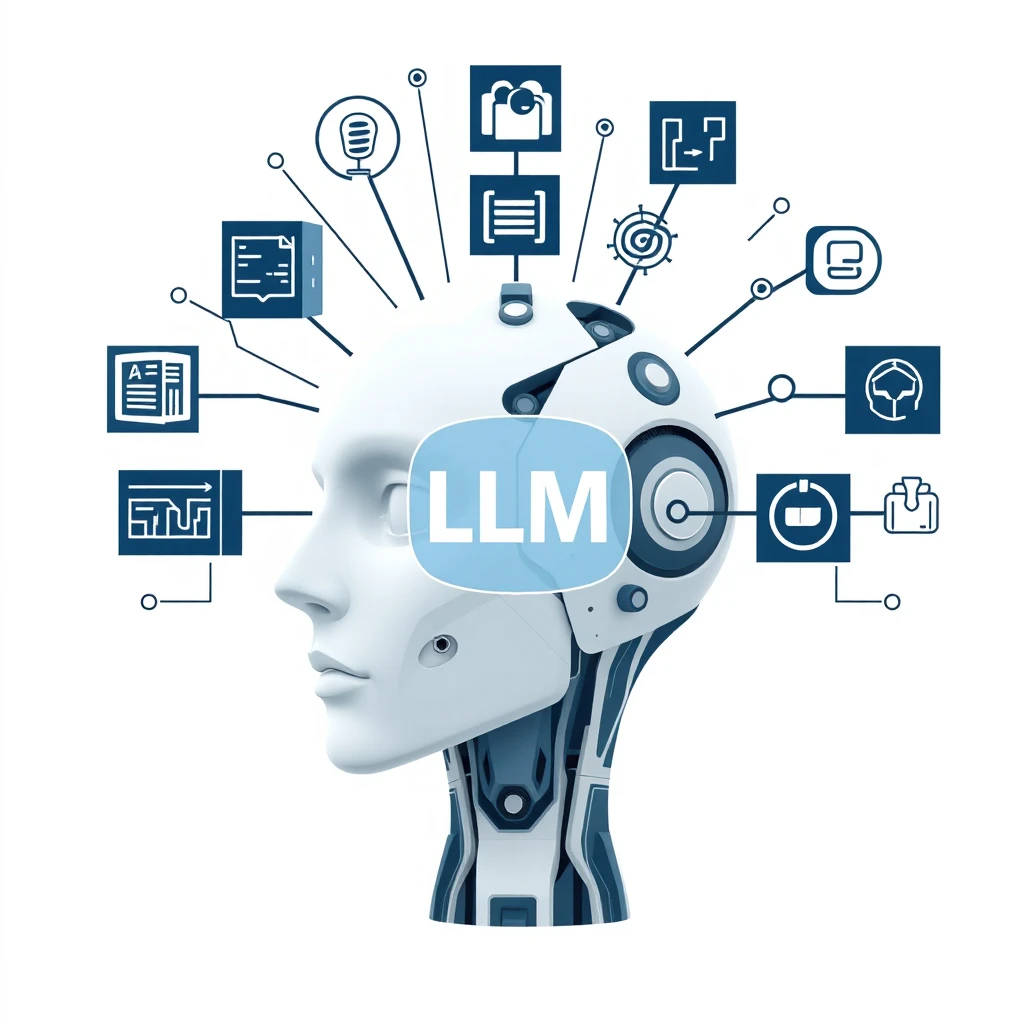Last Updated on April 5, 2025 by Editor
Are you running an organization? Are you sure your employees are only using company-approved AI tools? What if they are secretly relying on unauthorized AI applications that could be exposing your company’s sensitive data? Shadow AI is the silent disruptor infiltrating workplaces—employees using AI without IT or compliance approval, often unknowingly risking data leaks, compliance violations, and cybersecurity threats. As AI adoption skyrockets, organizations that fail to address Shadow AI risk falling behind in security and control. Don’t let your company become the next cautionary tale—act now before Shadow AI takes over your enterprise from the inside!
Key Takeaways
- Shadow AI is rapidly growing as employees seek unauthorized AI tools to boost productivity.
- Major risks include data security breaches, compliance violations, and AI hallucinations.
- Detection methods such as API monitoring and AI audits help organizations uncover Shadow AI usage.
- Governance strategies, including AI policies, training programs, and approved AI tools, are essential for mitigating risks.
- The future of AI regulation will require organizations to adopt strict compliance measures to manage AI safely.
What is Shadow AI?
Artificial intelligence has transformed how businesses operate, boosting productivity and efficiency across industries. However, as AI adoption grows, so does its unauthorized use—a phenomenon known as Shadow AI. This term refers to employees using unapproved AI tools without the oversight of IT or compliance teams, posing significant risks to organizations.
From generating automated reports to assisting in coding tasks, Shadow AI is becoming increasingly common. While it offers undeniable benefits, it also raises serious concerns about security, compliance, and data integrity. This article explores the causes, risks, detection methods, and mitigation strategies for Shadow AI, helping businesses navigate this evolving challenge.
The Rise of Shadow AI: Why Employees Use Unapproved AI Tools
Despite strict IT policies, employees are turning to AI tools outside of corporate-approved systems. Why? The answer lies in a combination of factors:
Productivity Over Compliance
Employees often face time-consuming manual tasks that AI can automate in seconds. If company-approved AI tools are slow, complex, or unavailable, workers will seek faster alternatives—even if it means using unauthorized AI tools like ChatGPT, Gemini, DeepSeek, Copilot or MidJourney.
Limited IT-Sanctioned AI Tools
Many organizations impose strict limitations on AI tools due to security risks. However, these restrictions often fail to align with employee needs, leading to workarounds.
Lack of AI Awareness & Training
Some employees may not fully understand the risks associated with using unauthorized AI tools. They may assume AI is safe and reliable, unaware that it can expose sensitive corporate data.
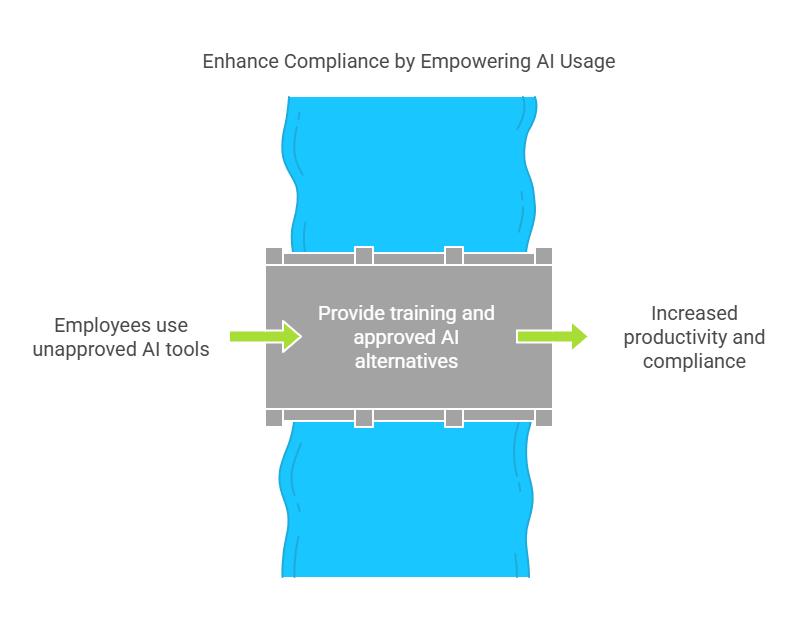
The Hidden Dangers of Shadow AI
While Shadow AI might seem like a harmless shortcut, it comes with severe risks that can damage an organization’s security, reputation, and regulatory standing.
Data Security Breaches
Unapproved AI tools often store user data on external servers, exposing confidential business information to unknown third parties. High-profile data leaks, such as Samsung’s AI code leak, have demonstrated the dangers of failing to control AI use within organizations.
Regulatory & Compliance Violations
Many industries operate under strict regulations like GDPR, HIPAA, and SOC 2. If employees unknowingly share sensitive data with non-compliant AI tools, organizations face heavy fines and legal consequences.
AI Hallucinations & Misinformation
AI tools are prone to hallucinations, meaning they can generate false, misleading, or biased information. In sectors like finance and healthcare, relying on incorrect AI-generated insights could lead to costly errors and reputational damage.
Shadow IT Expansion
Shadow AI is a subset of Shadow IT, where employees use unapproved software and hardware. If left unchecked, it can spiral into a larger IT security crisis, making it difficult for organizations to track and control sensitive data flow.
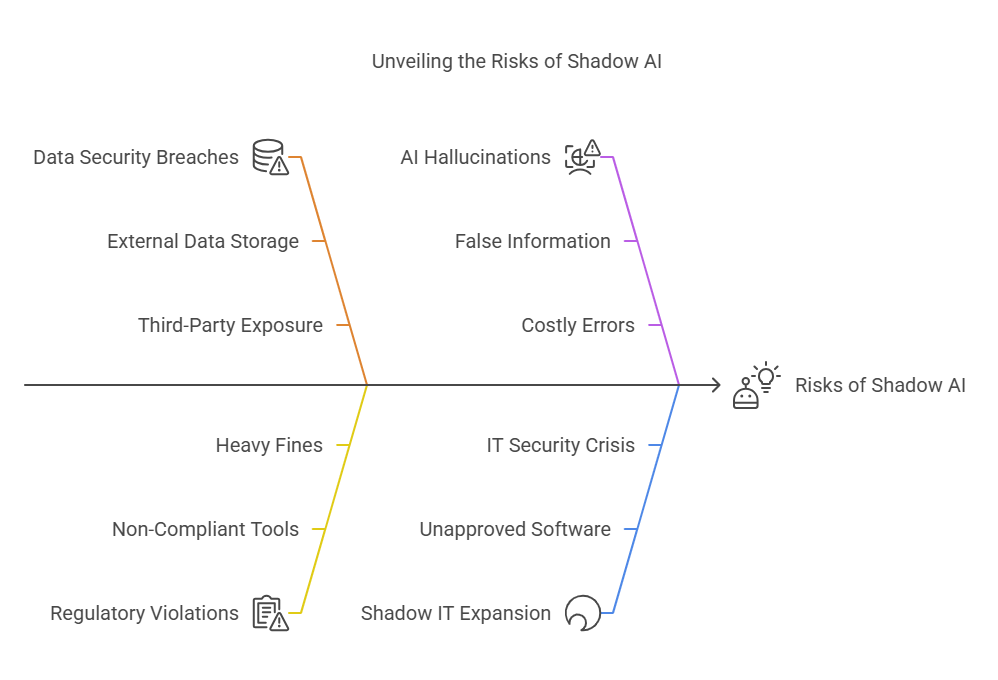
How to Detect Shadow AI in Your Organization
Identifying Shadow AI usage requires a combination of technical monitoring and cultural awareness. Companies can implement the following methods to uncover unauthorized AI adoption:
API & Network Traffic Analysis
IT teams can track suspicious API calls and unusual data transmissions to detect unauthorized AI activity. Cloud access logs also provide insights into AI tool interactions.
Employee AI Usage Surveys
Encouraging employees to self-report AI tool usage through anonymous surveys can reveal the extent of Shadow AI adoption. “AI Amnesty” programs help foster transparency.
AI Usage Audits
Conducting regular audits of employee workflows can highlight unapproved AI dependencies, helping IT teams implement secure AI alternatives.
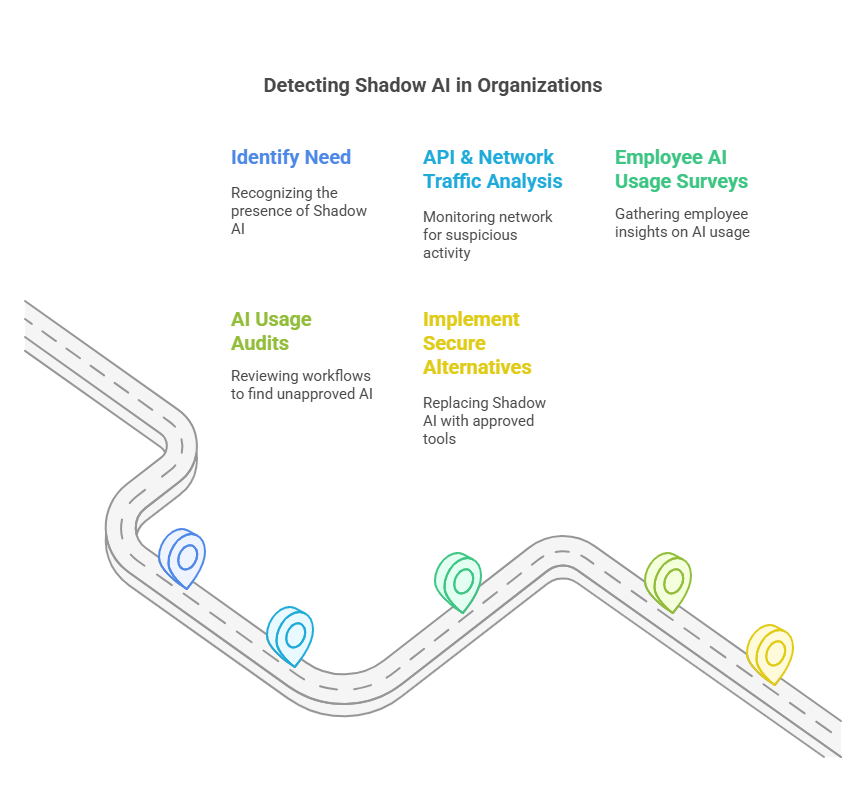
Strategies to Manage & Mitigate Shadow AI Risks
While eliminating Shadow AI completely is unrealistic, organizations can implement proactive governance strategies to reduce its risks.
Establish a Clear AI Policy
Organizations should create a formal AI usage policy that outlines:
- Approved AI tools and their use cases
- Data protection guidelines for AI interactions
- Consequences of unauthorized AI tool usage
Implement AI Governance Frameworks
A structured AI governance model ensures accountability at every level. Key components include:
- Departmental AI stewards to oversee AI usage within teams
- Continuous AI risk assessments
- Periodic AI training programs
Provide Secure AI Alternatives
Instead of banning AI outright, organizations should offer company-approved AI tools that align with employee needs while meeting security standards. AI vendor security evaluations help select the safest tools.
Employee Education & Awareness Programs
Educating employees on AI risks, compliance, and best practices helps mitigate Shadow AI adoption. Organizations should conduct regular training sessions to keep staff informed about evolving AI threats.
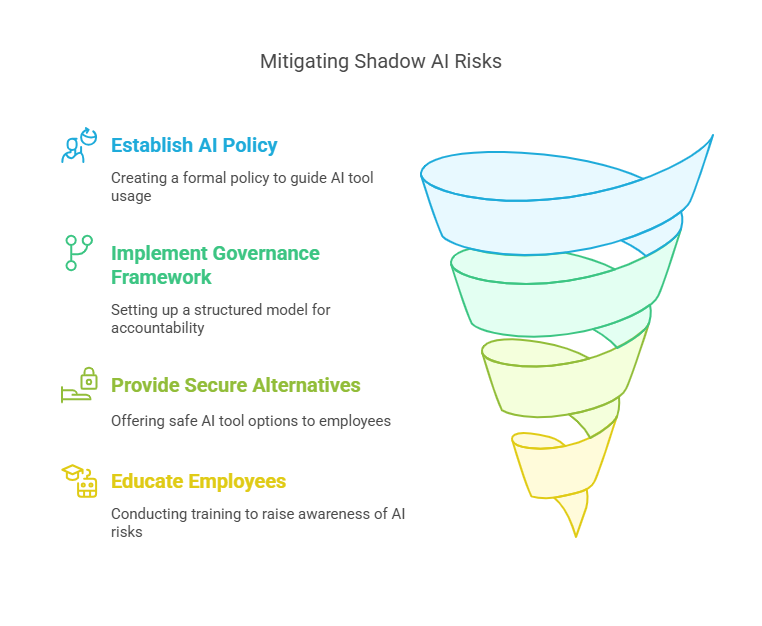
The Future of Shadow AI: What’s Next?
As AI technology continues to evolve, so will the challenges surrounding Shadow AI. Organizations must stay ahead by adopting AI responsibly, implementing strong governance policies, and leveraging AI-powered monitoring tools to detect unauthorized usage.
Governments worldwide are also introducing stricter AI regulations, such as the EU AI Act, which will shape how businesses handle AI in the future. Staying compliant with these evolving standards is crucial to avoiding legal pitfalls.
FAQ
Sources and More Reads
For a deeper understanding of Shadow AI and its impact on businesses, we encourage you to explore this section. Here, you’ll find valuable insights, expert analyses, and real-world case studies to enhance your knowledge and stay ahead of emerging AI risks. Stay informed, stay secure!
- What is Shadow AI? Risks and solutions for businesses
- Shadow vs AI: Unveiling the Dual Shadows of Unapproved Technology
- Study Finds Half of Employees Using Unauthorized AI Tools
- Shadow AI: How Employees Are Leading the Charge in AI Adoption and Putting Company Data at Risk
- Shadow AI in 2025: A Wake-Up Call
- Navigating the Risks of Shadow AI
- My Predictions for AI in 2025: Shadow AI
- What is Shadow AI and What Can Be Done About It?
- Shadow AI: What Is It and How Does It Work in Practice?
- Shadow AI: Insights from Thought Leaders
- Digital Workplace Trends to Watch in 2025
- Employees Are Embracing Shadow AI and Putting Company Data at Risk
- Understanding Shadow AI
- Understanding Shadow AI: A Comprehensive Guide
- Master Guide to Automated Decision Making: Combining Automation and AI to Empower Your Business
- Difference Between Shadow AI and Shadow IT
- Why Shadow AI is a Bigger Challenge Than Shadow IT
- Shadow AI on the Rise: Sensitive Data Input by Workers Up 156%
- Half of Workers Use Unauthorized AI at Work and Don’t Want to Quit Software AG
- 2025 Prediction: Shadow IT Will Become LoB (Line of Business) AI
- Unauthorized Use of AI: A Growing Concern
- Shadow AI: A Growing Security Threat
- 80% of Employees Admit Using Unapproved AI Tools—A Call for Control!
- Rising Shadows: Navigating Shadow AI in 2025
- Unauthorized AI Tools in the Workplace: What You Need to Know
- Understanding Shadow AI: Challenges and Solutions
- Glossary of Terms Related to Shadow AI
- The Rise of Shadow AI: Harnessing Innovation Without Compromising Security
- IBM’s Insights on Shadow AI Trends and Implications
- How Employees Are Leading the Charge in Shadow AI Adoption and Risks to Company Data
- What is Shadow AI? Understanding Its Impact on Organizations
- Key Risks of Shadow IT vs Shadow AI and How to Manage Them Effectively
- Get Ready for Shadow Agentic AI in 2025! What You Need to Know!
- Are Your Data Strategies Strong Enough to De-Risk AI Adoption? Insights from CIO Magazine
- Unauthorized AI is Eating Your Company Data Thanks to Your Employees! Learn More!




